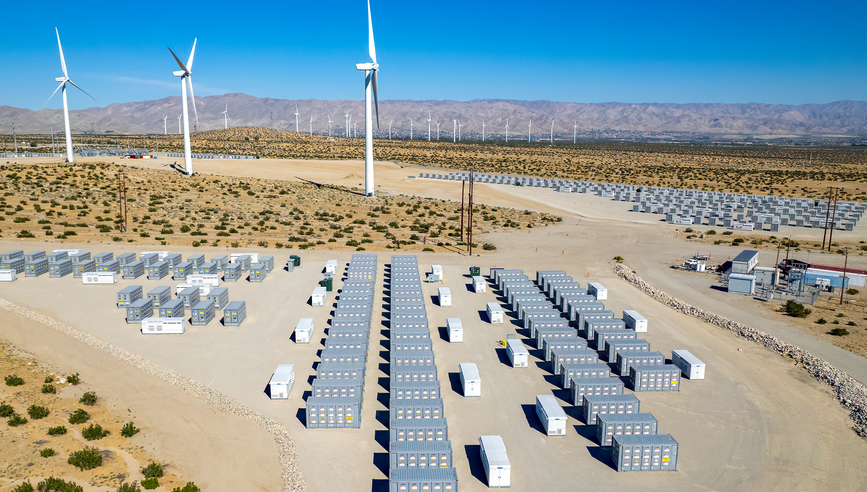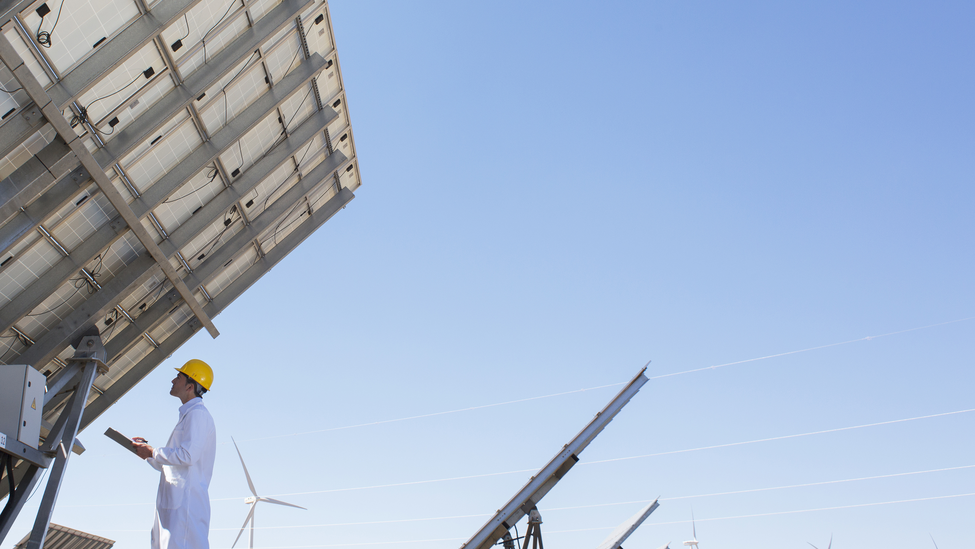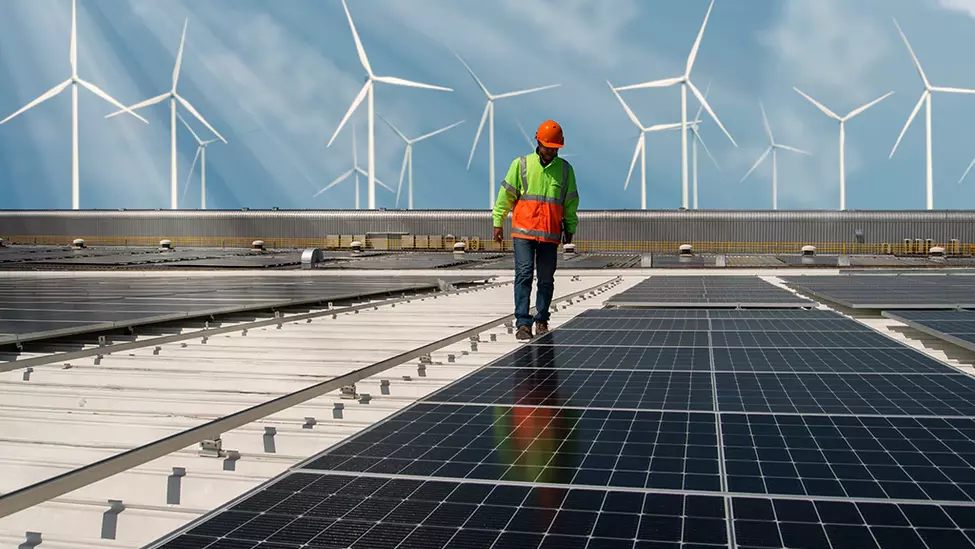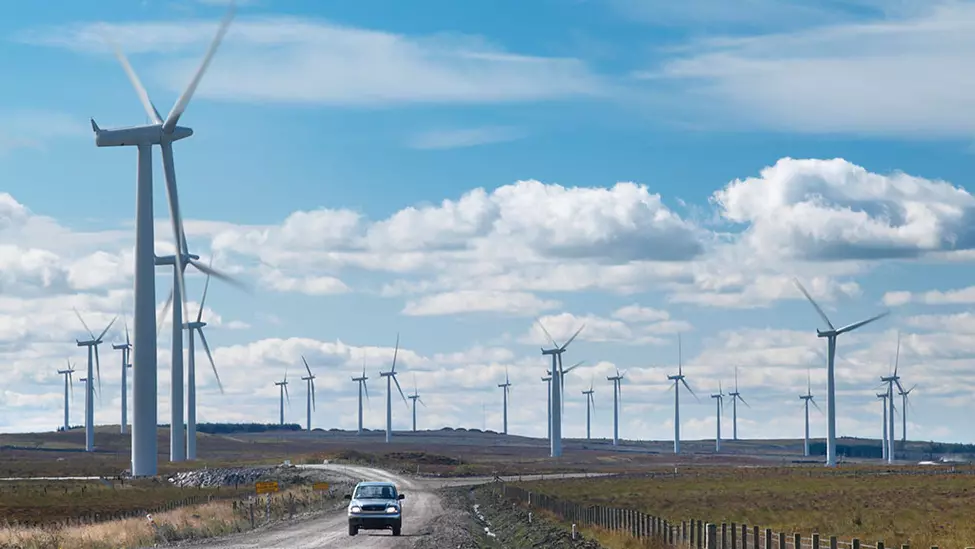Why Vegetation Management Is Vital to Renewable Energy

(DESCRIPTION)
Logo, Travelers. Text, Why Vegetation Management Is Vital to Renewable Energy.
(SPEECH)
What are the risks with plant overgrowth for renewable energy operations?
(DESCRIPTION)
A solar panel is overshadowed by growing vegetation. Icons of a fire, a tree, a chewed wire, and a mudslide appear.
(SPEECH)
Plant overgrowth can become fuel for wildfires, which could lead to heat exposure to solar panel systems. It can damage solar panels due to uneven shading, and also create habitats for snakes or rodents who can chew wires or get into inverters. If there is a reduction in vegetation, it could lead to mudslides or flooding from stormwater.
Having a vegetation management plan is a first step for safe and efficient renewable energy sites.
(DESCRIPTION)
A red book with a leaf on it appears.
TEXT, Vegetation Management Plan, Safe, Efficient
(SPEECH)
The best plan can address: controlling and eliminating unwanted vegetation that can threaten equipment,
(DESCRIPTION)
The plants surrounding the solar panel shrivel and disappear. A hand and watering can icon plant new seeds.
(SPEECH)
planting and maintaining helpful vegetation that can protect equipment, maintaining the correct vegetation height, and creating a stormwater management plan for proper drainage.
(DESCRIPTION)
Shears clip vegetation. Storm clouds and rain appear and drain into an irrigation channel.
(SPEECH)
But…. vegetation management only goes so far… and won't prevent every risk for renewable energy companies.
(DESCRIPTION)
TEXT, Vegetation Management Plan
(SPEECH)
With Travelers, renewable energy companies are supported from providing information for the planning process, all the way to the event of a claim.
(DESCRIPTION)
A timeline appears over the Travelers Logo with the following markers: TEXT, Planning Process, Event of a Claim
(DESCRIPTION)
An icon of a woman appears with an icon of a web browser. TEXT, Risk Control Consultants, MyTravelers® Risk Control
(SPEECH)
Renewable energy risk management may seem complex, but Travelers has resources to help: Travelers Risk Control Consultants can provide recommendations to help keep your operations safe from wildfires, flooding, and similar hazards.
(DESCRIPTION)
Yellow icons appear next to the following hazards: TEXT, Wildfires, Flooding, Similar Hazards
(SPEECH)
The Risk Control section of MyTravelers® offers an extensive library of tools to help with everything from disaster preparedness to business continuity planning.
(DESCRIPTION)
A cursor hovers over a library of red boxes. TEXT, MyTravelers® Risk Control, Disaster Preparedness, Business Continuity Planning
(SPEECH)
And, should a claim arise, Travelers Claim professionals have specialized training and extensive experience covering every angle of the renewable energy landscape.
(DESCRIPTION)
Logo, Travelers
(SPEECH)
Ask your insurance agent about Travelers solutions for renewable energy.
(DESCRIPTION)
Logo, Travelers TEXT, To learn more speak with your independent agent or visit us at travelers.com/VegetationManagement
(SPEECH)
Visit us at travelers.com/VegetationManagement to learn more.
(DESCRIPTION)
TEXT, © 2023 The Travelers Indemnity Company. All rights reserved. This material does not amend, or otherwise affect, the provisions or coverages of any insurance policy or bond issued by Travelers. It is not a representation that coverage does or does not exist for any particular claim or loss under any such policy or bond. Coverage depends on the facts and circumstances involved in the claim or loss, all applicable policy or bond provisions, and any applicable law. Availability of coverage referenced in this document can depend on underwriting qualifications and state regulations.
Renewable energy is the fastest-growing energy source in the United States, increasing 42% from 2010 to 2020 (up 90% from 2000 to 2020).1 As development of renewable energy operations continues to increase, so too does the appropriation of the land these facilities reside on. Wind farms, solar installations and other forms of clean power tend to take up more space on a per-watt basis than fossil fuel burning facilities. Without proper management, vegetation on these sites may significantly increase the threat of wildfire spread and property damage, as well as result in reduced functionality.
A buildup of dry vegetation under single axis trackers or fixed tilt arrays, for example, can become a potential fuel source for a fire. And when vegetation grows too tall around solar installations, it can create shading that reduces output. To mitigate these types of threats, vegetation management should be one of the first things a developer considers while planning a large solar array. Given the time, money and effort spent planning and installing renewable energy projects, companies that build and run these operations have a great incentive to protect their investments in assets and infrastructure with strategic maintenance. When vegetation management is neglected, you put your business at risk of equipment damage and other losses. The best maintenance plans include effective, site-specific vegetation management.
What Is vegetation management?
Vegetation management encompasses:
- Planting and maintaining helpful plants that protect equipment.
- Controlling and eliminating unwanted plants that threaten equipment.
- Creating a stormwater management plan for proper drainage.
- Maintaining the correct vegetation height and preventing overgrown weeds.
To ensure your vegetation management plan is well-executed, make sure all working crews are properly trained. This can include a formal site orientation with an overall view of the project, hazard analysis, emergency response, hot work and smoking controls, and the means of vegetation controls, including mowing method and use of trimmers, as well as pruning and tree removal. Examples of vegetation management include removing hazardous trees, controlling weeds, and planting hedges. Most asset owners contract with qualified operations and maintenance (O&M) providers to manage their vegetation as part of an overall custom maintenance plan.
Ask your O&M provider for an explanation of how they plan to manage vegetation and how often they perform various maintenance tasks. Once a plan is agreed upon, ensure the vegetation management strategy is outlined – including how a site will be vegetated, maintained and monitored – in the maintenance contract.
Renewable energy companies can mitigate the risk of property loss with a strong vegetation management strategy
Many losses renewable energy companies incur are due to poor vegetation management. Sparse ground cover can lead to mudslides, and poorly maintained vegetation can damage solar panels due to uneven shading or by causing fires. Long, dry grasses growing close to modules, for instance, can ignite from a single spark near a junction box or from solar cell failure. When this happens, companies may not only sustain property loss, but can also suffer from reduced output or service interruption, which can lead to loss of business income. They must also spend money to service and/or repair equipment and systems.
Mitigating vegetation risks and controlling them with thorough O&M procedures and documentation can help prevent problems before they occur. Monitoring the growth of vegetation is important year-round. Without strong vegetation management in place, companies may fall victim to the following, often manageable, threats:
![]()
Fire
Plant overgrowth can turn into fuel for wildfires. Ensure vegetation is monitored on a monthly basis, including under photovoltaic (PV) modules and around any electrical terminations, to clear overgrowth as needed. This risk can be increased if a lithium-ion battery energy storage system (BESS), a technology used on many wind farms and solar arrays, is present. These battery systems can also make traditional firefighting techniques more difficult and if damaged by fire, may present additional hazards to firefighters.
![]()
Flooding
Unmanaged vegetation can obstruct stormwater flow, or when ground cover isn't present, soil can fail to absorb water quickly. Both scenarios may lead to flooding. Mitigate potential flooding issues by installing inverters and other equipment above base flood elevation (BFE) levels for the specific project site. And consider planting and maintaining vegetation that can help prevent flooding.
![]()
Erosion and Mudslides
When vegetation is in poor health or in low supply, it may not hold soil in place or soak up water in the event of a storm. Standing water can speed erosion and lead to destabilized, muddy ground, which can put equipment at risk and hinders maintenance efforts.
![]()
Overheating and Hot Spots
It’s always important to prohibit heat and ignition sources near installations. Not only is it wise to regularly inspect and maintain fire breaks, buffers and cleared areas around electrical equipment, but it is also important to recognize that vegetation may cause hot spots. Uneven shading, for instance, can result in hot spots that cause equipment to overheat and malfunction.
![]()
Unwelcome Wildlife
Poorly managed vegetation can create habitats for wildlife such as snakes and vermin. Rodents can chew wires and even get into inverters. These pests not only threaten equipment but also can endanger nearby workers.
Design a vegetation management plan for your site
Vegetation management plans should be specific to each site. Most plans include a mix of management strategies depending on the following site factors:
- Climate
- Landscape
- Types of naturally occurring vegetation
- Access
- Local jurisdiction
Often, the best way to manage vegetation is with a strategy that includes several tactics. Typically, these will fall into three categories: manual cutting, prevention and planned landscapes.
Manual cutting
Cutting vegetation can help deter pests from nesting and help protect your equipment. It can be done by people, livestock (e.g., sheep) or even automated GPS robots. Whether you keep vegetation under control by manual mowing, contracting a local farmer with sheep or utilizing robotic mowers, make sure the vegetation doesn't get too low. If it does, that can affect the overall health of your groundcover and compromise ground stability. Wind and rain could sweep away your soil.
Prevention
Prevention methods for eliminating unwanted vegetation comes in several forms, including herbicides, weed-control sheets, and fences or hedges:
- Herbicides. Depending on the types of chemicals in the herbicide and their application, this method can last for years. That may make herbicides a good option for remote locations, where permitted.
- Weed-control sheets. Plastic sheets can create barriers to help prevent weeds from growing. These can be a good option for steep terrain that can pose challenges to mowing.
Planned landscapes
Strategically planting the right vegetation can help protect your installations, especially in areas prone to storms. Stormwater can cause erosion. If the erosion gets too severe, it can undermine your equipment's stability. Appropriate ground cover plants can soak up rainwater and help hold soil in place.
Another way to mitigate this damage is to plan a stormwater management system. The system can be as simple as a series of ditches that direct water away from your equipment, though sometimes pumps may be required. Your O&M provider can help you determine the best way to manage stormwater.
Find the right mix for your site
Chemical weed prevention may be the simplest and cheapest option for controlling vegetation on your site, but you can only pursue that route if local regulations permit the use of certain herbicides. If they might harm protected local species or violate environmental rules, you'd have to take another course of action, such as weed-control sheets.
Whatever your vegetation management plan includes, it should cover frequency. That could be how often to apply herbicides, when to replace weed-control sheets, and which times of year to complement preventive weed control with manual cutting.
Work with a knowledgeable insurance carrier
The renewable energy industry is constantly evolving – and so are its risks. Each type of renewable – from solar to wind to biomass – has unique exposures. That's why Travelers has Risk Control professionals dedicated to the renewable industry.
For clients, Travelers Risk Control consultants can provide recommendations, derived from their deep understanding of the renewable energy industry and how it’s evolving, to help mitigate risks. Clients also benefit from the resources in the Risk Control section of MyTravelers® for Business that offers an extensive library of content to help clients address both the broad and industry-specific risks facing their businesses. This library includes tools and content to guide clients in areas such as operational maintenance, contractual risk transfer, business continuity planning and safety on the road.
And should a claim arise, Travelers energy clients will work with Claim professionals who are dedicated to the energy industry. Their specialized training and extensive experience cover every angle of the renewable energy landscape, from manufacturing and installation to complex technical processes and specialty equipment. These Claim professionals also have access to the technical expertise of the Travelers Forensics Lab, which can help them reconstruct actual accidents endured by renewable energy clients. They are committed to helping clients secure supporting evidence to investigate and help defend their claim and to providing the best claim experience possible.
Ask your insurance agent about Travelers insurance solutions for renewable energy operations.



